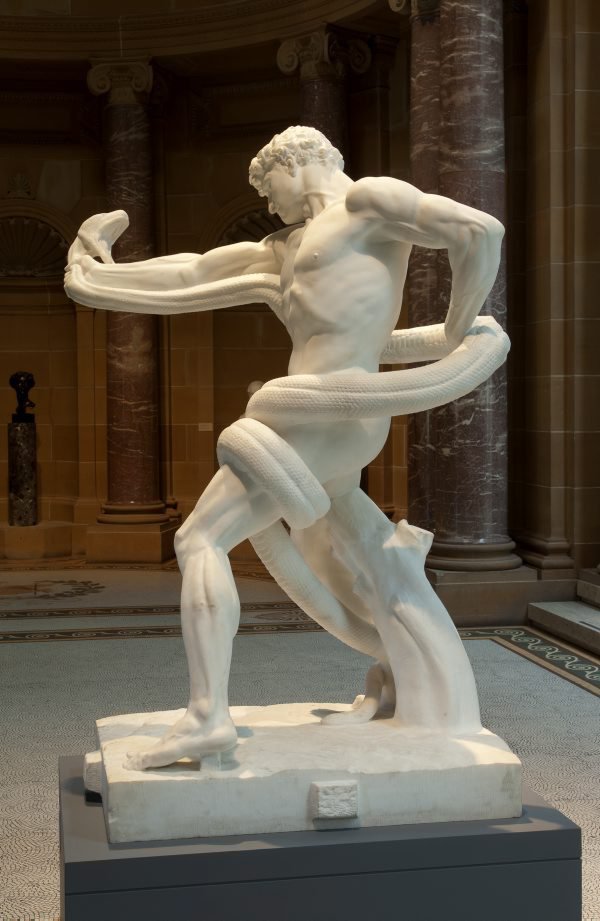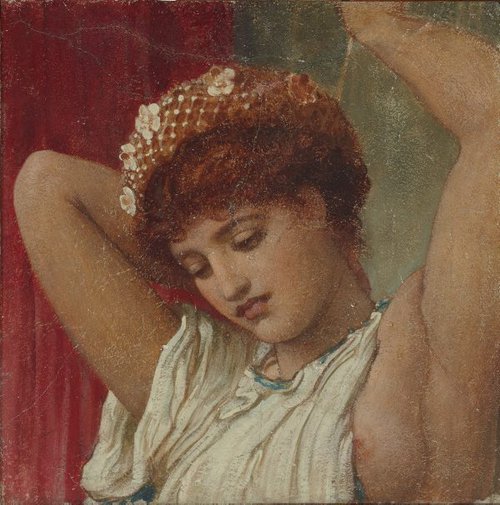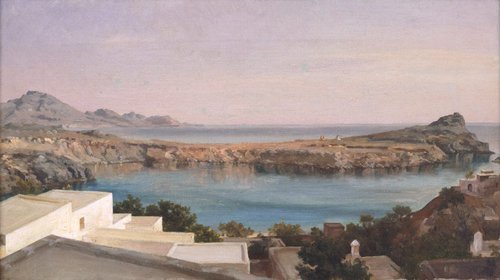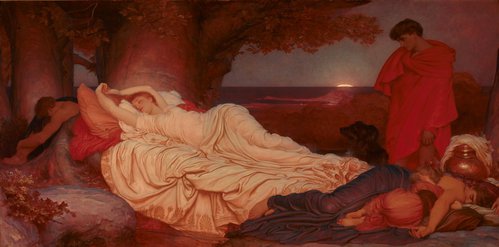Title
An athlete wrestling with a python
1888-1891
Artist
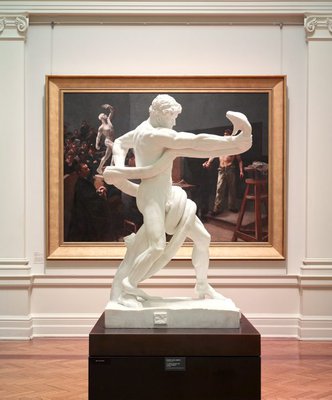
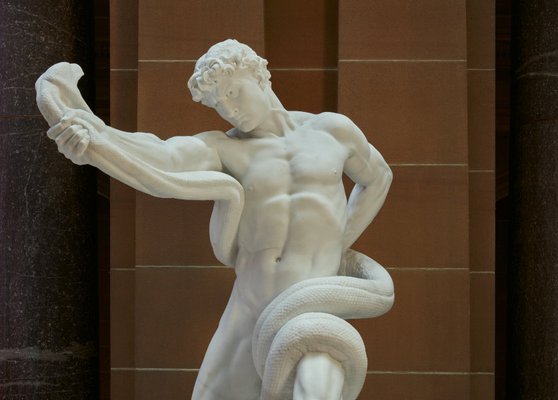
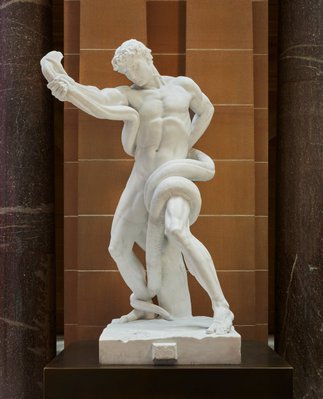
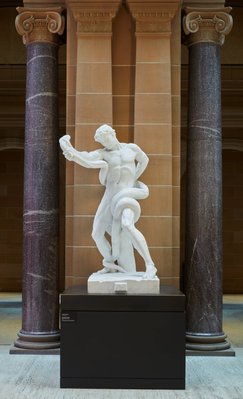
-
Details
- Other Title
- An athlete struggling with a python
- Date
- 1888-1891
- Media category
- Sculpture
- Materials used
- white marble
- Dimensions
- 178.0 cm high
- Signature & date
Not signed. Not dated.
- Credit
- Gift of John Schaeffer AO 2017. Donated through the Australian Government's Cultural Gifts Program
- Location
- South Building, ground level, Kaldor Hall
- Accession number
- 183.2017
- Copyright
- Artist information
-
Frederic, Lord Leighton
Works in the collection
- Share
-
-
About
The idea of a heroic male nude struggling with a python came to Leighton as he was working on his huge canvas of the 'Daphnephoria' (now in the Lady Lever Art Gallery, Port Sunlight, UK). He was making clay models of some of his figures in the painting to help work out the composition, so he modelled this figure in clay as well. A French sculptor, probably Jules Dalou advised him to execute the figure on a large scale. Leighton took up the idea and started working on the full-scale model in the winter of 1874-75. He worked in a sculpture studio in London, made available to him by his friend and protégé, the young sculptor Thomas Brock (1847–1922). The figure was studied from life. Leighton was happy to let Brock help with the mechanics of enlarging the small sculpture to life-size while leaving ‘the artistic individuality of the work wholly mine’.
Leighton looked to antiquity for inspiration, to the perfectly poised and proportioned male nude of Greek sculpture, and invested it with a new vitality achieved through close attention not only to the skeletal and muscular structure of the body, but even to such details as veins. This new surface naturalism was applied to a figure no longer in a pose of languid equilibrium, as the Greek canon generally required, but to a figure involved in a desperate mortal combat, straining every human faculty to its limit. The famous Hellenistic group of 'Laocoön' and his sons struggling with serpents (in the Vatican Museums, Rome) was an obvious model, but Leighton invested his figure with even greater determination and energy.
The figure was cast by the foundry Cox & Sons and made its public debut at the Royal Academy in 1877, the year before Leighton became President. The work was very positively received and hailed as ‘one of the finest things he has produced’, ‘a performance pre-eminent in life and energy’, ‘nobly classic in feeling, yet full of such realistic detail as modern anatomical knowledge demands’.(1) Oscar Wilde thought the statue worthy of being looked on side-by-side with the 'Laocoön', while Henry James enjoyed ‘this representation of the naked human body, the whole story of which begins and ends with the beautiful play of its muscles and limbs’.(2)
Further endorsement of the 'Athlete'’s significance followed. The Leicester Galleries published an edition of small bronze replicas, bringing it within the range of the modest collector and the domestic setting, while the gold medal which the sculpture was awarded at the Paris 'Exposition Universelle' in 1878 laid the foundations of its international reputation. This present version was another sign of this phenomenon. In 1887, Carl Jacobsen (1842–1914), owner of the Carlsberg brewery in Copenhagen, commissioned the present marble replica from Leighton for the Ny Carlsberg Glyptotek, a museum he had founded in 1882 and which he gave to the city of Copenhagen in 1888. Jacobsen was keen to acquire contemporary works of sculpture in marble and Leighton initially resisted the idea of working in marble, trying to persuade Jacobsen to take a second bronze cast. But the Dane insisted and in January 1888 Leighton set about finding a suitable block of marble. The figure had not been designed for stability in marble and an additional stump under his left heel had to be added at the rear as a support as well as a tree trunk behind the athlete. Most of the carving was undertaken under Leighton’s supervision by Frederick Pomeroy (1856-1924). However, when he finally dispatched the piece to Copenhagen in December 1890, Leighton wrote to Jacobsen to stress that he had devoted ‘nearly three months of my own labour to the marble’.
Before the marble was transported, Leighton obtained permission to exhibit it at the Royal Academy in 1891, but its reception was rather muted by comparison with that of its bronze counterpart 14 years earlier. Inevitably there were critics who felt the figure had worked better in the medium for which it had been first designed. But F G Stephens wrote loyally in 'The Athenaeum': ‘the character of the material demanded a higher degree of finish; but the new version lacks none of the characteristic vigour of the bronze one, and the artist has modelled it exquisitely’.(3) Claude Phillips in the 'Magazine of Art' voiced a more general view when he wrote of ‘the carefully studied, if too anxiously shown, muscular structure of the male figure, and that over-accentuation of the parts which so much detracts from the unity and vitality of the whole’.(4) Jacobsen himself was apparently delighted with the statute, for Leighton told his sister in a letter of 3 October 1891, that ‘in his [Jacobsen’s] opinion it is one of the most important statutes of modern times’. The marble was de-accessioned by the Ny Carlsberg Glyptotek in 1974 and has since been in private collections in London, New York and Sydney.
1. ‘Academy pictures’, The Builder, vol 35, no 1788, 12 May 1877, pp 471–73: p 471; WM Rossetti, ‘The Royal Academy exhibition (Fourth and concluding notice)’, The Academy, 16 June 1877, pp 539–40: p 539; ‘The Royal Academy exhibition’, Art Journal, vol 16, June 1877, pp 185–86: p 185
2. Oscar Wilde, ‘The Grosvenor Gallery’, Dublin University Magazine, vol 90, no 85, July 1877, pp 118–26: p 126; Henry James quoted in The painter’s eye: notes and essays on the pictorial arts, Hart-Davis, London, 1956, p 149
3. FG Stephens, ‘The Royal Academy (First notice)’, Athenaeum, no 3314, 2 May 1891, pp 572–78: p 573
4. Claude Phillips, ‘Sculpture of the year’, Magazine of Art, 1891, pp 402–07: p 402 -
Exhibition history
Shown in 4 exhibitions
Royal Academy of Arts, 1891, Royal Academy of Arts, London, 1891–1891
Victorian High Renaissance, The Minneapolis Institute of Arts, United States of America, 19 Nov 1978–07 Jan 1979
Victorian High Renaissance, Brooklyn Museum, United States of America, 10 Feb 1979–08 Apr 1979
Frederic, Lord Leighton, Royal Academy of Arts, London, 15 Feb 1996–21 Apr 1996
Victorian visions: nineteenth-century art from the John Schaeffer Collection, Art Gallery of New South Wales, Sydney, 20 May 2010–29 Aug 2010
-
Bibliography
Referenced in 37 publications
-
Art Gallery of New South Wales, Art Gallery of New South Wales annual report 2007, Sydney, 2007, p 22.
-
Art Gallery of New South Wales, Art Gallery of New South Wales annual report 2012–13, Sydney, 2013, p 100.
-
Art Gallery of New South Wales, Art Gallery of New South Wales annual report 2011–12, Sydney, 2012, p 90.
-
Art Gallery of New South Wales, Art Gallery of New South Wales annual report 2010–11, Sydney, 2011, p 113.
-
Art Gallery of New South Wales, Art Gallery of New South Wales annual report 2009–10, Sydney, 2010, p 24.
-
A L Baldry, The Studio, vol 15, no 68, 'The work of F W Pomeroy', London, Nov 1898, pp 77–85: p 84.
-
Mrs Russell Barrington, The life, letters and work of Frederic Leighton, 2 vols, London, 1906, vol 2, pp 200, 310, 391.
-
Richard Beresford, Victorian visions: nineteenth century art from the John Schaeffer collection, Sydney, 2010, pp 14, 16, 18, 66, 68, no 14, col illus pp 67, 69 (detail).
-
Richard Beresford, Look, 'Nobility and realism: heroic figure the start of a new era in sculpture', Sydney, Mar 2007, pp 22–24, col illus pp 22 (detail), 23.
-
Henry Blackburn (Editor), Academy notes 1891, London, 1891, illus p 135.
-
Alice Corkran, Frederick Leighton, London, 1904, pp 117, 212.
-
Richard Dorment, Victorian High Renaissance, Manchester, 1978, pp 119, 121, no 57, illus p 120.
-
DSM, The Spectator, no 3288, 'Art – Architecture and sculpture at the Academy', London, 04 Jul 1891, pp 13–14: p 14.
-
Michael Hatt, After the Pre-Raphaelites. Art and aestheticism in Victorian England, 'Physical culture: the male nude and sculpture in late Victorian Britain', New Brunswick, 1999, pp 240–56: p 243.
-
Stephen Jones, Christopher Newall, Leonée Ormond, Richard J. Ormond and Benedict Read, Frederic, Lord Leighton: eminent Victorian artist, London, 1996, pp 182–83, no 76, col illus p 183.
-
Christopher Newall, The art of Lord Leighton, Oxford, 1990, p 91.
-
Leonée Ormond and Richard J. Ormond, Lord Leighton, New Haven, 1975, pp 163, 171, no 361a.
-
Claude Phillips, Art Journal, 'Sculpture at the Royal Academy', London, Sep 1891, pp 261–62: p 262.
-
Claude Phillips, Magazine of Art, 'Sculpture of the year', London, 1891, pp 402–07: p 402.
-
Benedict Read, Lord Leighton 1830–1896 and Leighton House. A centenary celebration, 'Leighton as a sculptor. Releasing sculpture from convention', London, 1996, pp 65–69: p 68.
-
Benedict Read, Joanna Barnes and Alexander Kader, Leighton and his sculptural legacy: British sculpture 1875–1930, London, 1996, p 47.
-
Ernest Rhys, Frederic, Lord Leighton, late President of the Royal Academy of Arts: an illustrated record of his life and his work, London, 1898, pp 28, 37, 51, 90.
-
Ernest Rhys, Sir Frederic Leighton, Bart, PRA ..: an illustrated chronicle, London, 1895, p 72.
-
John Saxby, Look, 'The collector's story', Sydney, Sep 2017-Oct 2017, pp 33–34, col illus pp 32, 34 (both in situ).
-
MH Spielmann, Magazine of Art, 'The late Lord Leighton, PRA, DCL, LLD', London, 1896, pp 197–216: p 214.
-
Edgcumbe Staley, Lord Leighton of Stretton, PRA, London, 1906, pp 109, 145, 254.
-
Philip Ward-Jackson, Burlington Magazine, vol 138, no 1119, 'Leighton’s Sculptural Legacy', London, Jun 1996, pp 417–18: p 417.
-
Saturday Review, vol 71, no 1861, 'Sculpture in 1891', London, 27 Jun 1891, pp 778–79: p 778.
-
The Builder, vol 60, no 2522, 'Sculpture at the Royal Academy and New Gallery', London, 06 Jun 1891, pp 444–45: p 444.
-
Athenaeum, no 3319, 'The Royal Academy (Fifth and concluding notice)', London, 06 Jun 1891, pp 737–39: p 738.
-
Art Journal, 'Art gossip and reviews', London, Jun 1891, pp 191–92: p 191.
-
The Times, 'The Royal Academy (Fourth and concluding notice)', London, 26 May 1891, p 12.
-
Athenaeum, no 3314, 'The Royal Academy (First notice)', London, 02 May 1891, pp 572–78: p 573.
-
The exhibition of the Royal Academy of Arts. MDCCCXCI. The one hundred and twenty-third, London, 1891, p 64, no 2099.
-
The Forbes Collection of Victorian pictures and works of art, London, 19 Feb 2003, pp 188–91, no 28, col illus p 189.
-
Art Journal, 'The Summer exhibitions at home and abroad. I.', London, May 1891, pp 153–58: p 154.
-
Victorian, Pre-Raphaelite & British Impressionist art, London, 16 Dec 2015, p 33.
-
-
Provenance
Carl Jacobsen, 1888-1974, Copenhagen/Denmark, Commissioned by Carl Jacobsen for the Ny Carlsberg Glyptotek, Copenhagen, 1888. Delivered in 1891.
Daniel Katz Ltd, 1974, London/England, Deaccessioned by the Ny Carlsberg Glyptotek and sold to Daniel Katz, 1974.
John Lewis, 1975, London/England
Private Collection, post 1975, New York/United States of America, Then with Hirschl & Adler, New York.
Stuart Pivar, pre 1996, New York/United States of America, Stuart Pivar, New York, by 1996.
Christopher Forbes, post 1996, New York/United States of America, Acquired from Stuart Pivar by the Forbes Magazine Collection. Sold at Christie's London, 19 Feb 2003, lot 28, ₤400,000 (hammer price).
John Schaeffer, 19 Feb 2003, Sydney/New South Wales/Australia, Purchased at the above sale by John Schaeffer.
